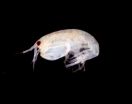(Press-News.org) RAPID CITY, S.D. (Feb. 28, 2013) – A South Dakota School of Mines & Technology assistant professor and his team have discovered a new species of herbivorous dinosaur and published the first fossil evidence of prehistoric crocodyliforms feeding on small dinosaurs.
Research by Clint Boyd, Ph.D., provides the first definitive evidence that plant-eating baby ornithopod dinosaurs were a food of choice for the crocodyliform, a now extinct relative of the crocodile family. While conducting their research, the team also discovered that this dinosaur prey was a previously unrecognized small ornithopod dinosaur species, which has yet to be named.
The evidence found in what is now known as the Grand Staircase Escalante-National Monument in southern Utah dates back to the late Cretaceous period, toward the end of the age of dinosaurs, and was published Feb. 27 in the academic journal PLOS ONE (Public Library of Science ONE). The complete research findings of Boyd and Stephanie K. Drumheller, of the University of Iowa and the University of Tennessee, and Terry A. Gates, of North Carolina State University and the Natural History Museum of Utah, can be accessed at http://dx.plos.org/10.1371/journal.pone.0057605.
A large number of mostly tiny bits of dinosaur bones were recovered in groups at four locations within the Utah park – which paleontologists and geologists know as the Upper Cretaceous (Campanian) Kaiparowits Formation – leading paleontologists to believe that crocodyliforms had fed on baby dinosaurs 1-2 meters in total length.
Evidence shows bite marks on bone joints, as well as breakthrough proof of a crocodyliform tooth still embedded in a dinosaur femur.
The findings are significant because historically dinosaurs have been depicted as the dominant species. "The traditional ideas you see in popular literature are that when little baby dinosaurs are either coming out of a nesting grounds or out somewhere on their own, they are normally having to worry about the theropod dinosaurs, the things like raptors or, on bigger scales, the T. rex. So this kind of adds a new dimension," Boyd said. "You had your dominant riverine carnivores, the crocodyliforms, attacking these herbivores as well, so they kind of had it coming from all sides."
Based on teeth marks left on bones and the large amounts of fragments left behind, it is believed the crocodyliforms were also diminutive in size, perhaps no more than 2 meters long. A larger species of crocodyliform would have been more likely to gulp down its prey without leaving behind traces of "busted up" bone fragments.
Until now, paleontologists had direct evidence only of "very large crocodyliforms" interacting with "very large dinosaurs."
"It's not often that you get events from the fossil record that are action-related," Boyd explained. "While you generally assume there was probably a lot more interaction going on, we didn't have any of that preserved in the fossil record yet. This is the first time that we have definitive evidence that you had this kind of partitioning, of your smaller crocodyliforms attacking the smaller herbivorous dinosaurs," he said, adding that this is only the second published instance of a crocodyliform tooth embedded in any prey animal in the fossil record.
"A lot of times you find material in close association or you can find some feeding marks or traces on the outside of the bone and you can hypothesize that maybe it was a certain animal doing this, but this was only the second time we have really good definitive evidence of a crocodyliform feeding on a prey animal and in this case an ornithischian dinosaur," Boyd said.
The high concentrations of tiny dinosaur bones led researchers to conclude a type of selection occurred, that crocodyliforms were preferentially feeding on these miniature dinosaurs. "Maybe it was closer to a nesting ground where baby dinosaurs would have been more abundant, and so the smaller crocodyliforms were hanging out there getting a lunch," Boyd added.
"When we started looking at all the other bones, we starting finding marks that are known to be diagnostic for crocodyliform feeding traces, so all that evidence coming together suddenly started to make sense as to why we were not finding good complete specimens of these little ornithischian dinosaurs," Boyd explained. "Most of the bites marks are concentrated around the joints, which is where the crocodyliform would tend to bite, and then, when they do their pulling or the death roll that they tend to do, the ends of the bones tend to snap off more often than not in those actions. That's why we were finding these fragmentary bones."
INFORMATION:
In the process of their research, the team discovered through diagnostic cranial material that these baby prey are a new, as yet-to-be-named dinosaur species. Details on this new species will soon be published in another paper.
View a School of Mines video interview with Boyd at http://youtu.be/UHP6BVasmwU.
Research unearths new dinosaur species
First fossil evidence shows small crocs fed on baby dinosaurs
2013-03-01
ELSE PRESS RELEASES FROM THIS DATE:
ACC/HRS release appropriate use criteria for ICDs and CRT
2013-03-01
WASHINGTON (Feb. 28, 2013) –The American College of Cardiology and the Heart Rhythm Society, along with key specialty societies, today released appropriate use criteria for implantable cardioverter-defibrillators (ICDs) and cardiac resynchronization therapy (CRT). The document provides assessed levels of appropriateness for implanting the devices in 369 real-life clinical scenarios, with the goal of enhancing physician and patient decision making and improving care and health outcomes.
Implantable cardioverter-defibrillators are devices that monitor the heart's rhythms ...
Sea lamprey genome mapped with help from scientists at OU
2013-03-01
Beginning in 2004, a group of scientists from around the globe, including two University of Oklahoma faculty members, set out to map the genome of the sea lamprey. The secrets of how this jawless vertebrate separated from the jawed vertebrates early in the evolutionary process will give insight to the ancestry of vertebrate characters and may help investigators more fully understand neurodegenerative diseases in humans.
David McCauley, associate professor in the Biology Department in the OU College of Arts and Sciences, and Sandra W. Clifton, with the OU Center for Advanced ...
Pour, shake and stir
2013-03-01
TORONTO, Ontario (Feb. 28, 2013) - A diagnostic "cocktail" containing a single drop of blood, a dribble of water, and a dose of DNA powder with gold particles could mean rapid diagnosis and treatment of the world's leading diseases in the near future. The cocktail diagnostic is a homegrown brew being developed by University of Toronto's Institute of Biomaterials and Biomedical Engineering (IBBME) PhD student Kyryl Zagorovsky and Professor Warren Chan that could change the way infectious diseases, from HPV and HIV to malaria, are diagnosed.
And it involves the same technology ...
NOAA and NASA's next generation weather satellite may provide earlier warnings
2013-03-01
A new satellite that will detect the lightning inside storm clouds may lead to valuable improvements in tornado detection. The GOES-R satellite is currently being built with new technology that may help provide earlier warnings for severe weather. The national average is a 14-minute lead time to warn residents of a tornado, but NASA and NOAA scientists are looking to improve severe weather detection to save lives and property. They are developing the Geostationary Operational Environmental Satellite-R Series, or GOES-R, to observe thunderstorm development with much greater ...
NASA's Van Allen Probes discover a surprise circling Earth
2013-03-01
After most NASA science spacecraft launches, researchers wait patiently for months as instruments on board are turned on one at a time, slowly ramped up to full power, and tested to make sure they work at full capacity. It's a rite of passage for any new satellite in space, and such a schedule was in place for the Van Allen Probes when they launched on Aug. 30, 2012, to study two giant belts of radiation that surround Earth.
But a group of scientists on the mission made a case for changing the plan. They asked that the Relativistic Electron Proton Telescope (REPT) be ...
Zeroing in on heart disease
2013-03-01
Studies screening the genome of hundreds of thousands of individuals (known as Genome-wide association studies or GWAS) have linked more than 100 regions in the genome to the risk of developing cardiovascular disease. Researchers from the European Molecular Biology Laboratory (EMBL) and the University of Heidelberg, through the joint Molecular Medicine Partnership Unit (MMPU), are taking these results one step further by pinpointing the exact genes that could have a role in the onset of the disease. Their findings are published today in the Public Library of Science (PLoS) ...
New marine species discovered in Pacific Ocean
2013-03-01
HOLLYWOOD Fla. — When Jim Thomas and his global team of researchers returned to the Madang Lagoon in Papua New Guinea, they discovered a treasure trove of new species unknown to science.
This is especially relevant as the research team consisted of scientists who had conducted a previous survey in the 1990s.
"In the Madang Lagoon, we went a half mile out off the leading edge of the active Australian Plate and were in 6,000 meters of water," said Thomas, Ph.D., a researcher at Nova Southeastern University's National Coral Reef Institute in Hollywood, Fla.
"It was ...
BPA raises risk for childhood asthma
2013-03-01
Researchers at the Columbia Center for Children's Environmental Health at the Mailman School of Public Health are the first to report an association between early childhood exposure to the chemical bisphenol A (BPA) and an elevated risk for asthma in young children. BPA is a component of some plastics and is found in food can liners and store receipts.
Results appear in the March edition of the Journal of Allergy and Clinical Immunology.
"Asthma prevalence has increased dramatically over the past 30 years, which suggests that some as-yet-undiscovered environmental exposures ...
Pharmaceutical companies: An $84 million marketing effort in the District of Columbia
2013-03-01
Washington, D.C.—Drug companies spent nearly $84 million marketing pharmaceuticals in the District of Columbia in 2011, including an outlay of nearly $19 million for gifts given to physicians, hospitals and other health care providers, according to a report by researchers at the George Washington University School of Public Health and Health Services (SPHHS). The report notes that 12 physicians in the District received gifts (including consulting payments) that totaled more than $100,000 apiece that one year alone.
"There is nothing inherently wrong with such gifts," ...
Cancer doesn't change young girls' desire to have children, Moffitt Cancer Center study shows
2013-03-01
Researchers at Moffitt Cancer Center and colleagues have found that healthy adolescent females have predetermined expectations for becoming parents in the future, but have concerns about fertility and childbearing should they develop a life-threatening illness, such as cancer.
The study appeared in the February issue of the Journal of Adolescent Health.
According to the researchers, this study helped further validate a tool that seeks to understand teenage girls' hopes and feelings about reproduction, especially when fertility is threatened by cancer. The participants ...
LAST 30 PRESS RELEASES:
Kids’ behavioral health is a growing share of family health costs
Day & night: Cancer disrupts the brain’s natural rhythm
COVID-19 vaccination significantly reduces risk to pregnant women and baby
The role of vaccination in maternal and perinatal outcomes associated with COVID-19 in pregnancy
Mayo Clinic smartwatch system helps parents shorten and defuse children's severe tantrums early
Behavioral health spending spikes to 40% of all children’s health expenditures, nearly doubling in a decade
Digital cognitive behavioral treatment for generalized anxiety disorder
Expenditures for pediatric behavioral health care over time and estimated family financial burden
Air conditioning in nursing homes and mortality during extreme heat
The Alps to lose a record number of glaciers in the next decade
What makes a good proton conductor?
New science reporting guide published for journalists in Bulgaria
New international study reveals major survival gaps among children with cancer
New science reporting guide published for journalists in Turkey
Scientists develop a smarter mRNA therapy that knows which cells to target
Neuroanatomy-informed brain–machine hybrid intelligence for robust acoustic target detection
Eight SwRI hydrogen projects funded by ENERGYWERX
The Lundquist Institute and its start-up company Vitalex Biosciences Announces Strategic Advancement of Second-Generation fungal Vaccine VXV-01 through Phase 1 Trials under $40 Million Competitive Con
Fine particles in pollution are associated with early signs of autoimmune disease
Review article | Towards a Global Ground-Based Earth Observatory (GGBEO): Leveraging existing systems and networks
Penn and UMich create world’s smallest programmable, autonomous robots
Cleveland researchers launch first major study to address ‘hidden performance killer’ in athletes
To connect across politics, try saying what you oppose
Modulating key interaction prevents virus from entering cells
Project explores barriers to NHS career progression facing international medical graduates
Jeonbuk National University researchers explore the impact of different seasonings on the flavor perception of Doenjang soup
Two Keck Medicine of USC Hospitals named Leapfrog Top Teaching Hospitals
World-first discovery uncovers how glioblastoma tumours dodge chemotherapy, potentially opening the door to new treatments
A fatal mix-up: How certain gut bacteria drive multiple sclerosis
New AI tool identifies not just genetic mutations, but the diseases they may cause
[Press-News.org] Research unearths new dinosaur speciesFirst fossil evidence shows small crocs fed on baby dinosaurs



